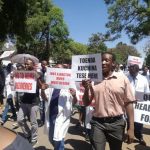The existing businessmen didn’t take too kindly to these new arrivals, he says. Soon, the Meikles decided to set up their own store, and it was with the cheapest materials they could rustle up. Straight away, they priced the products they had brought in a way to undercut the competition.
“Consequently a very rough shelter was run up, using the whiskey cases for a wall and buck-sail for a roof. We were soon ready to start business. Sugar was selling at 1/6d. per lb. and we reduced it to 6d., and other things in proportion, the result being that whatever little business was done came to us. Our fresh stocks were an additional attraction. Flour was unprocurable until then.”
Stewart remained to run the business as Tom and John returned to Pretoria to pick up more stock ordered from Durban.
“This is the story of the start of the firm of Meikle Brothers. Little did we think at the time that business would grow and develop as it has done, that the firm would eventually take a leading part in the commercial life of the country. Most things have small beginnings and our venture was one of them.”
The business was growing nicely, but it needed a whole lot more to break out into more than just a corner store in a dusty outpost. This is where Allan Wilson becomes central to the story of the Meikles.
To conquer the land, Cecil John Rhodes had hired groups of settlers to repress the natives. The man heading that effort was Allan Wilson, described as skilled in the art of “kaffir warfare”. As payment, those fighting under Wilson got a farm of “3000 morgen” (2600 hectates today), 20 gold claims and a share of the plunder, “such loot being Lobengula’s personal cattle”.
As John Meikle states in his diary, Rhodes set up what he called a “Looting Committee”. John was trusted by Rhodes to have a leading role in this Looting Committee. “Farm rights were also being sold for ten pounds each and loot rights were fetching twelve pounds,” he notes.
Rhodes, Meikles writes, “gave me seventy men and ammunition and told me to kill as many cattle as I wanted for food”.
He describes how “Wilson and myself made south with the loot cattle, a bellowing confusion of oxen, cows and calves”.
Of course, there was some good in all this, John Meikle wants us to believe. Lobengula had stolen the cattle himself, and women too, he says. The column had liberated these captives while looting the cattle, he argued.
“In addition to the cattle, about 600 head, we brought 30 women, most of them with one or two children. These were eventually restored to their own people in the Victoria district”.
By the time it was done, the Loot Committee “eventually accounted for three hundred and sixty two thousand head of cattle”.
Continued next page
(262 VIEWS)


